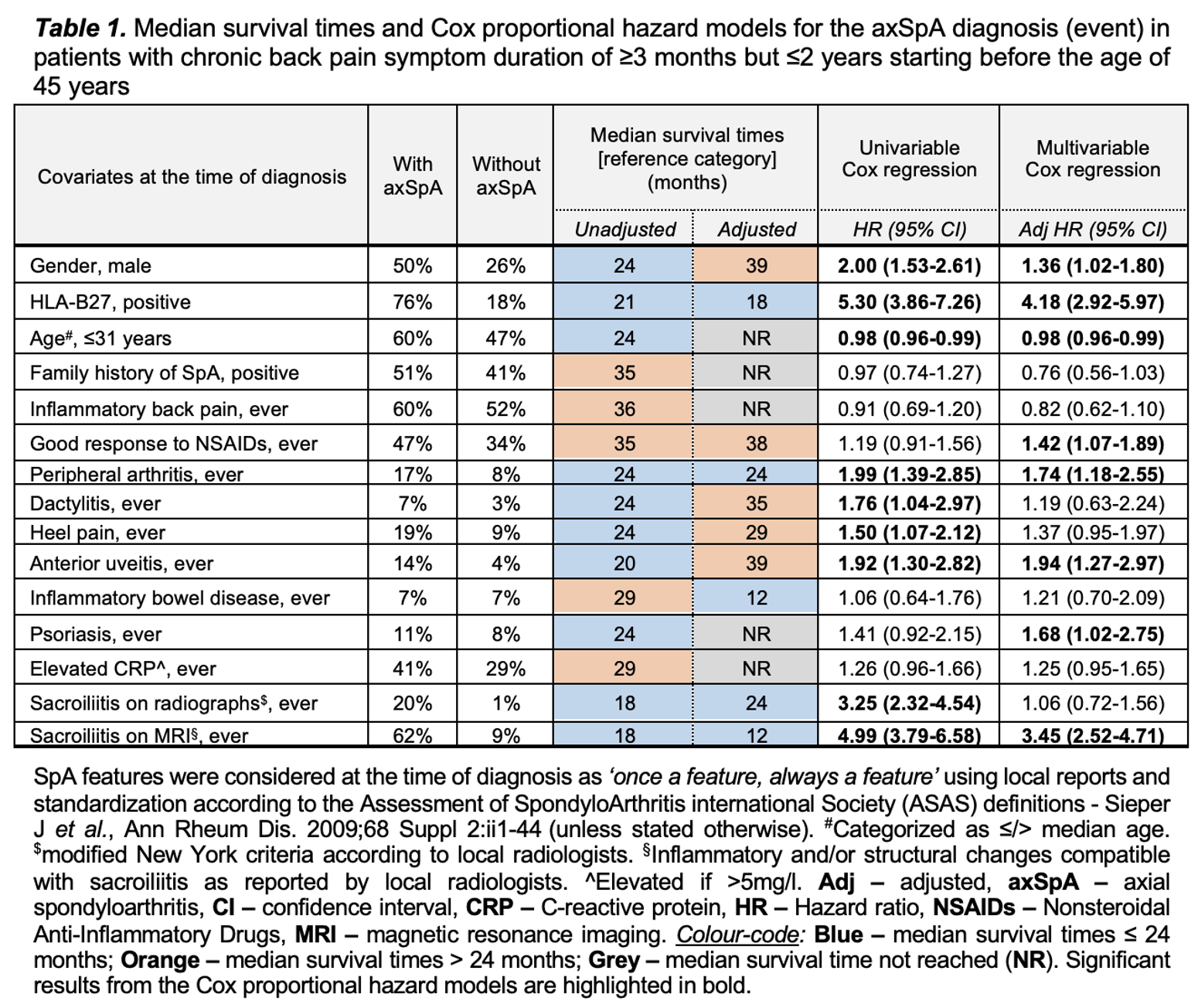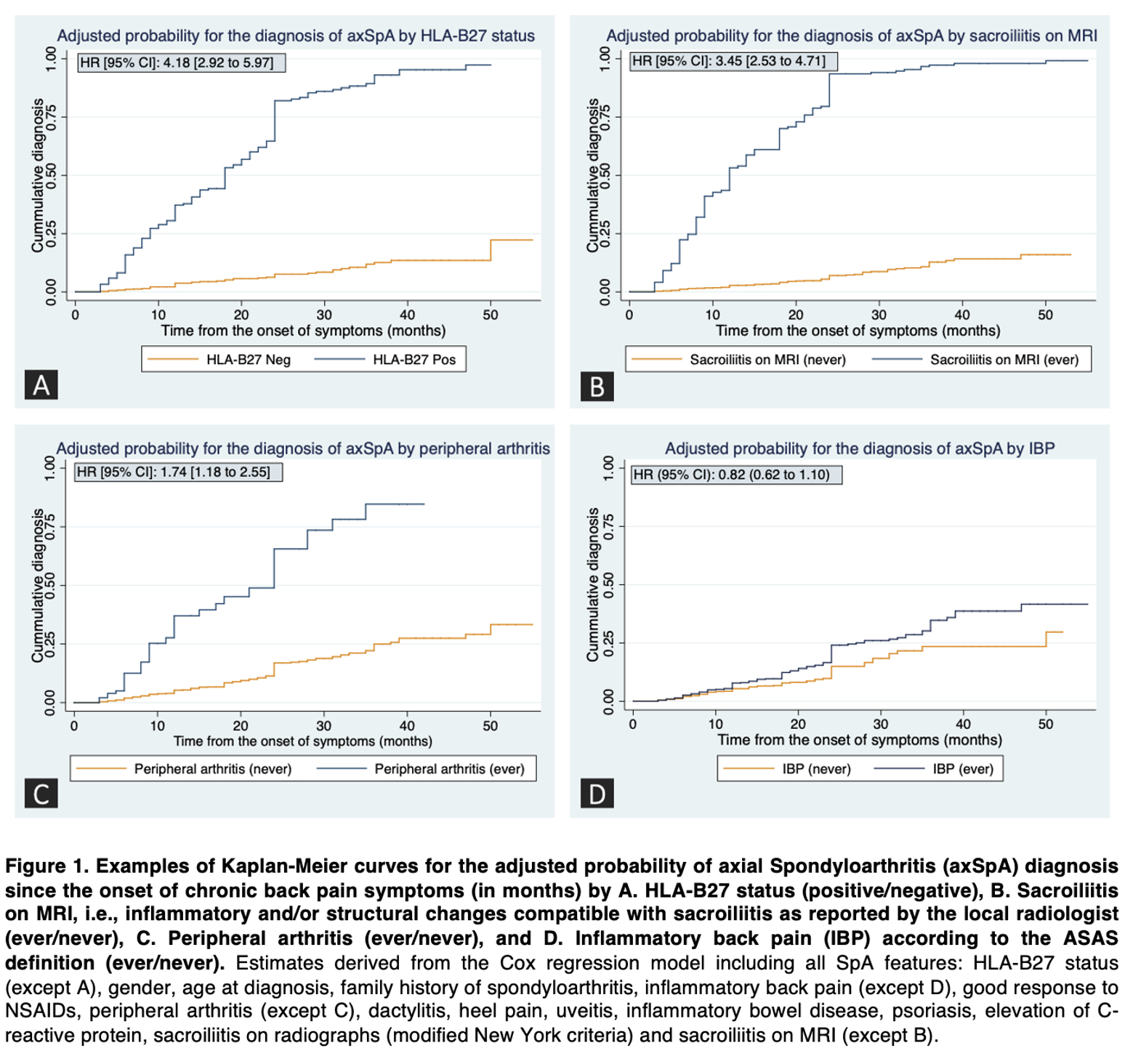Session Information
Date: Saturday, November 16, 2024
Title: SpA Including PsA – Diagnosis, Manifestations, & Outcomes Poster I
Session Type: Poster Session A
Session Time: 10:30AM-12:30PM
Background/Purpose: Patients with chronic back pain (CBP) of less than two-years (2y) duration suspected of axial spondyloarthritis (axSpA) referred to the rheumatologist can be reliably diagnosed (Marques ML, et al. 2024). However, the time to diagnosis from symptom onset and its determinants remain poorly studied in patients with recent-onset CBP. We aimed to investigate the time to diagnosis after symptom onset in patients with CBP suspected of axSpA referred to the rheumatologist and assess the main determinants for an early axSpA diagnosis.
Methods: We analyzed the 2y-data from the SPondyloArthritis Caught Early (SPACE) multi-center cohort of patients (< 45y) with CBP (≥3 months, ≤2y) of unknown origin. Clinical, laboratory, and imaging SpA features were collected over time. An event was defined as an axSpA diagnosis with level of confidence (LoC)≥7 at last observation or LoC< 7 in ≥2 last consecutive visits. Time to event (months) was computed from symptom onset to the first visit with the event. Patients without the event were censored at 2y or loss to follow-up. SpA features were considered at the time of diagnosis. Median survival times were computed overall and per SpA feature (un-/adjusted for covariates). Univariable and multivariable Cox-regression models identified axSpA diagnosis determinants. The final multivariable model allowed subgroup comparisons for time-to-event by SpA feature, adjusting for other SpA features (adjusted Kaplan-Meier curves).
Results: The SPACE cohort included 548 unknown-origin CBP patients with information on diagnosis, LoC and symptom duration. These were included in the survival analysis (mean [SD] age:31[8] years, symptom duration:13[7] months, males:35%, HLA-B27 positivity:41%). Overall, 215 (39%) received a 2y diagnosis of axSpA (median time to diagnosis: 35 months). As expected, the axSpA group showed a higher prevalence of SpA features (Table 1). The lowest adjusted median survival times (up to 24 months) were observed for sacroiliitis on radiographs (8 months), sacroiliitis on MRI (12 months), inflammatory bowel disease (12 months), HLA-B27 positivity (18 months) and peripheral arthritis (24 months) (Table 1). Kaplan-Meier curves showed median survival times and diagnosis probability (Figure 1). A contrasting example of a SpA feature not determining the diagnosis (inflammatory back pain) is also shown. Multivariable Cox regression models emphasized HLA-B27 positivity and sacroiliitis on MRI as the strongest determinants implying a 4.2- and 3.5-times adjusted higher likelihood for the diagnosis of axSpA, respectively (Table 1). Peripheral arthritis, anterior uveitis or psoriasis implied each ~2-times higher risk for the axSpA diagnosis. Good response to NSAIDs, male sex and a younger age increased the probability for the diagnosis of axSpA slightly.
Conclusion: Half of the patients with CBP suspected of axSpA referred to the rheumatologist received the diagnosis within the first 35 months after symptom onset. HLA-B27 positivity, sacroiliitis on imaging and peripheral arthritis are the SpA features most contributing to an early (up to 2y after symptom onset) diagnosis of axSpA in these patients.
To cite this abstract in AMA style:
Marques M, van der Heijde D, de Bruin L, van Lunteren M, Landewé R, Minde Fagerli K, Van Oosterhout M, van Gaalen F, Ramiro S. How Early Is Early? Unveiling Time to Diagnosis Since Symptom Onset and Its Determinants in Patients Suspected of Early Axial Spondyloarthritis: Data from the SPondyloArthritis Caught Early (SPACE) Cohort [abstract]. Arthritis Rheumatol. 2024; 76 (suppl 9). https://acrabstracts.org/abstract/how-early-is-early-unveiling-time-to-diagnosis-since-symptom-onset-and-its-determinants-in-patients-suspected-of-early-axial-spondyloarthritis-data-from-the-spondyloarthritis-caught-early-space-co/. Accessed .« Back to ACR Convergence 2024
ACR Meeting Abstracts - https://acrabstracts.org/abstract/how-early-is-early-unveiling-time-to-diagnosis-since-symptom-onset-and-its-determinants-in-patients-suspected-of-early-axial-spondyloarthritis-data-from-the-spondyloarthritis-caught-early-space-co/


